Colmar 作者: 来源: 发布时间:2021-09-26
I.Population and Area
Region: Alsace
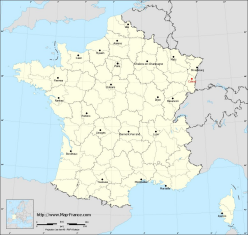
Department: Haut-Rhin
Code Insee : 68066
Code postal :68000
Total Area: 66.57 km²
Population in 2017: 69 105
Population Density: 1000 /km²
Location: Colmar is 64 kilometres (40 mi) south-southwest of Strasbourg, at 48.08°N, 7.36°E, on the Lauch River, a tributary of the Ill. It is located directly to the east of the Vosges and connected to the Rhine in the east by a canal. Colmar is located 10 miles west of the Rhine River, bordering the German frontier and a few miles east of the foothills of the Vosges Mountains. It is on the main railway from Strasbourg to Mulhouse and Basel, Switzerland.
Histogram of demographic change
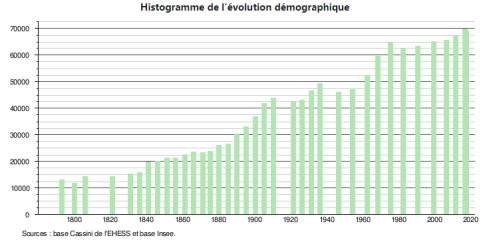
Sources : http://www.cartesfrance.fr/carte-france-ville/68066_Colmar.html
II.Natural Geography
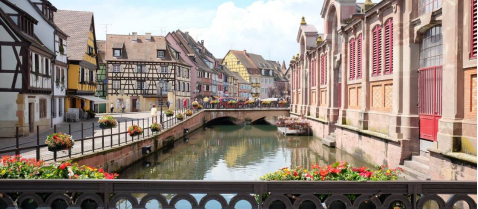
Geographical environment: Colmar is located to the north of the potassium basin and the sub-Vosges coal basin but also to the south of the coal basin of the Villé valley. The area of the municipality is 6,657 hectares; its altitude varies between 175 and 214 meters. The territory of Colmar is the third largest in Alsace after Haguenau (18,259 hectares) and Strasbourg (7,826 hectares).
Climat: Colmar is subject to an atypical, semi-continental climate, and some years, a steppe climate. As such, it is one of the driest municipalities in France with 607 mm of rain per year. No month has really heavy rains, with the exception of May. The dryness results from the town's location next to mountains, which force clouds arriving from the west to rise, and much of their moisture to condense and fall as precipitation over the higher ground, leaving the air warmed and dried by the time it reaches Colmar. Summers are warm, while winters are moderately cold. In addition, Colmar rarely experiences significant snowfall (due to the drier climate). However, on March 4, 2006, more than 40 cm of snow fell in a day, which had not happened for almost twenty years.
Natural environment and biodiversity: Many other parks and gardens are scattered throughout the city, including the Saint François-Xavier park (9,980 m2), the Méquillet park (5,753 m2), the Hirn square (French garden) or the square de la Montagne -Green (3,273 m2). Besides, the western part of the Le parc du château d'eau is a magnificent rose garden extending over 450 m2 and composed of 990 plants divided into 38 varieties.
Transport:
(1) Traffic in the city: The TRACE bus network (TRAnsports de Colmar et Environs), created in 1990, originally served three municipalities: Colmar, Horbourg-Wihr and Wintzenheim. It is one of the first networks in France to have put into service buses running on natural gas from 1998. The Trace network is currently one of the cleanest urban transport networks in France with more than 90% of buses (37 out of a total of 41 operated) running with natural gas engines. In 2015, TRACE operates sixteen lines from Monday to Saturday (nine urban lines 1, 2, 3, 4, 5, 6, 7, 8 and 9) and seven interurban lines (lines 20, 21, 22, 23, 24, 25 and 26), three lines on Sundays and public holidays (lines A, B and C), an event line (line E) and a minibus on request for people with reduced mobility. Since April 27, 2019, small electric buses have been running in the city center. And from July 15 to August 31, 2020, the Trace bus network will be free throughout Colmar.
(2) Trains:
Colmar station is the main station in the agglomeration, located in the middle of the Strasbourg - Mulhouse - Basel rail axis.The railway station Colmar station offers connections to Strasbourg, Mulhouse, Besançon, Zürich and several regional destinations. The town also has two other railway stops assigned to TER traffic, the Colmar-Saint-Joseph and Colmar-Mésanges stations.
Since June 10, 2007, the city has been linked to high speed thanks to the commissioning of the first section of the East European LGV. Two daily round trips to Paris-Est are scheduled. The second phase of this high-speed line, opened in July 2016, reduced the best journey time between Colmar and Paris to 2 h 30 min compared to more than 4 h 30 min previously.
On December 11, 2011, the eastern branch of the new Rhine-Rhône high-speed line was put into service between Dijon and Mulhouse. This makes it possible to connect Colmar and Lyon in 3 h 15 min, with two extensions to Marseille in around 5 h. Besides, the rail link between Colmar and Friborg could be restored by 2026-2027.
(3) Airport: The small regional Colmar-Houssen Airport serves Colmar. Colmar-Houssen airport was created in 1953, it is mainly used for business and sports aviation. Since 1960, it has also enabled business aviation. Used for emergency medical transport, it is therefore open 24 hours a day. Two international airports are located within 45 minutes, Strasbourg-Entzheim airport and Bâle-Mulhouse-Friborg airport, both with direct access by the motorway.
Sources : https://www.colmar.fr/actualites/bus-trace-gratuits-tout-lete
https://www.britannica.com/place/Colmar
III.Economy
Regional economy: The economy of Alsace ranks first among the richest French regions in France with 2.6% of France's GDP, and a GDP per capita of 31,700 euros in 2017. The region is relatively prosperous, with varied economic activity.
Colmar is an affluent city whose primary economic strength lies in the flourishing tourist industry. But it is also the seat of several large companies: Timken (European seat), Liebherr (French seat), Leitz (French seat), Capsugel France (A division of Pfizer).
Income: According to Insee, in 2014, the inhabitants of Colmar earn on average € 2 368 net per month, or € 28 414 net per year.
Companies: More than 70% of the companies operate in the field of trade-transport-services, while 16% operate related to the administrative sector.
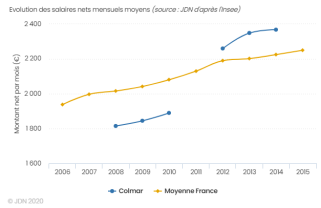
Evolution of average monthly net wages
Sources : http://www.journaldunet.com/business/salaire/colmar/ville-68066
https://ec.europa.eu/eurostat/documents/2995521/9618272/1-26022019-AP-FR.pdf
IV.Industrial Characterisitics
Colmar is an economic and tourist engine in central Alsace. Its main areas of the economy are electromechanics, the pharmaceutical industry, purchasing centers and building materials. Besides, Colmar is a wine-trading centre and commands an industrial port zone on the Rhine at Neuf-Brisach. Industrialization, much of it by foreign investors, is comparatively recent and includes precision engineering, along with the manufacture of synthetic fibres and electronic machines.
Tourist: Colmar is not only one of the ten most charming towns in the world, but also the third most beautiful tourist destination in Europe. Colmar is the prototype of "Howl's Moving Castle". The green train that appeared in the movie is actually a small town tour bus in reality. Colmar, city of art and history, very restored and maintained, largely pedestrian or "semi-pedestrian" attracts each year nearly 3.5 million tourists from all over the world coming mainly from Europe, America and from Japan.
Wine industry: The Alsace vineyard, appreciated since the Middle Ages and omnipresent to the west of the city in the Vosges piedmont, benefits from a particularly favorable climate. The Interprofessional Council for Alsace Wines (CIVA), which brings together multiple unions of winegrowers-owners, merchants and cooperators, is based in Colmar. This organization facilitates relations between producers and buyers and carries out studies on the production and marketing of Alsace wines.
The manufacture of aeronautical equipment:
Sources: https://www.britannica.com/place/Colmar
V.Attractions
1. Old-town & Place de la Cathédrale
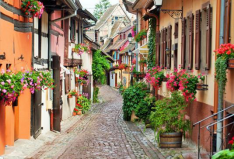
Mostly spared from the destructions of the French Revolution and the wars of 1870–1871, 1914–1918 and 1939–1945, the cityscape of old-town Colmar is homogenous and renowned among tourists. Seemingly right out of a storybook, the charming Old Town of Colmar is a captivating maze of winding cobblestone streets lined with typical Alsatian burghers' houses. This well-preserved historic area lies between the Rue des Têtes, the Rue des Clefs, and the Rue des Marchands near the Place de la Cathédrale.
Visitors may begin a tour of Colmar at the Place de la Cathédrale, in the very heart of Colmar's old town. On this square is the Collégiale Saint-Martin (Saint-Martin Collegiate Church), originally a Gothic church that was largely rebuilt in the 18th century. Another important historic monument on the Place de la Cathédrale is the Ancien Corps de Garde (Former Guard House) which has served many purposes, from a marketplace building to a justice hall and military housing. This historic edifice is a jewel of Alsatian Renaissance architecture. The Maison Adolph also graces the square at 16 Place de la Cathédrale. Built in 1350 for the Adolph family, this lovely house is one of the oldest buildings in Colmar. Next to the Maison Adolph is a well featuring two lion heads that dates to 1592.
Continue sightseeing on the Grand Rue (a short walk away) and visit the Eglise Saint-Matthieu, a 13th-century Protestant church. A must-see attraction nearby is the Maison Pfister at the corner of the Rue Mercière and the Rue des Marchands. Blending medieval and Renaissance styles, this building is one of the finest old houses in Colmar. The home was built in 1537 for Ludwig Scherer, a hatter who made his fortune in money trading. On the Rue des Marchands is the Bartholdi Museum that displays mementos of the famous sculptor Auguste Bartholdi who was born here. Next, stroll along the Rue des Boulangers (Bakers' street) and the Rue des Serruriers (Locksmiths' Street) to admire the picturesque half-timbered houses. Be sure to stop in front of 19 Rue des Têtes, to see the Maison des Têtes (the "House of Heads"). This ornate Renaissance building features a facade decorated with small busts and the faces of different personages. The building is now occupied by a five-star hotel with a renowned gastronomic restaurant.
Source: https://www.planetware.com/tourist-attractions-/colmar-f-a-col.htm
2.The Unterlinden Museum
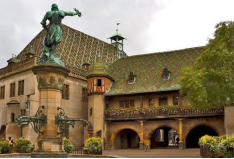
The Unterlinden Museum (French: Musée Unterlinden) housed in a 13th-century Dominican religious sisters' convent and a 1906 former public baths building, is home to the Isenheim Altarpiece by Matthias Grünewald and features a large collection of local and international artworks and manufactured artifacts from prehistorical to contemporary times. It is the most visited in Alsace,with roughly 200,000 visitors per year.
This exceptional museum is located in the former Dominican convent that dates back to the 13th century, with a beautifully preserved double-arcaded cloister. In 2015, the museum expanded its gallery space with an adjoining building that occupies the town's former municipal baths. The Unterlinden Museum has an extensive collection of Romanesque and Gothic sculpture, medieval paintings, folk art, and crafts. The first floor is devoted to Alsatian toys, furniture, and decorative objects (porcelain, faience, stained glass, and prints). One of the highlights of the museum is the Isenheim Chapel, which contains fine paintings by early German artists, including Passion scenes by Martin Schongauer and works by Isenmann and Lucas Cranach the Elder. The chief treasure of the chapel is Matthias Grünewald's Isenheim Altar, one of the most moving masterpieces of German painting. This imaginative work of glowing color was painted around 1515 for the convent of Isenheim near Guebwiller. The museum also has a lapidary collection, as well as religious art. The museum's contemporary art collection includes Picasso, Léger, Rouault, Mathieu, Vasarely, and Braque.
Collections: Famous above all for the Isenheim Altarpiece by Matthias Grünewald, it also displays a major collection of Upper Rhenish medieval and early Renaissance art, among which the Colmar native Martin Schongauer occupies the most prominent place with several altarpieces and a large number of original drawings, engravings and woodcuts. Other famous names include Albrecht Dürer (engravings only), Lucas Cranach the Elder and Hans Holbein the Elder as well as local painters Caspar Isenmann, Jost Haller and Wilhelm Stetter. Most of the earliest paintings, however, are the work of anonymous German, Alsatian or Swiss masters, such as the Master of the Stauffenberg Altarpiece. Other sections displayed by the museum are : local and international archeology; medieval, Renaissance and baroque sculpture (religious as well as profane) and stained glass; weapons, furniture, music instruments and toys from the 14th to the 19th century; ancient, ornate wine barrels (a collection donated by Jean-Jacques Waltz in 1927); modern and contemporary art.
Address: 1 Rue d'Unterlinden, Colmar
Source: https://www.musee-unterlinden.com/en/museum/history-of-the-museum/
https://www.planetware.com/tourist-attractions-/colmar-f-a-col.htm
3.The Colmar municipal theater
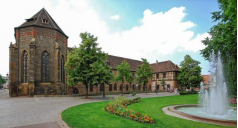
The Colmar municipal theater hosts more than 100 performances each year and brings together around 35,000 spectators. The municipal theater manages its own program which comes in various series: Comedies - Family Sunday - Humor in Music - Song. The theater also hosts various shows or concerts offered by associations such as AJAM, Le Conservatoire, Les Musicales, the Théâtre Alsacien de Colmar and various dance schools or Colmar associations.
History: The first theater built in Haute-Alsace, the municipal theater of Colmar opened its doors on March 8, 1849. This building offers an elegant classic exterior "à la française" on the prospect of rue Kléber, with five windows on the ground floor and as many upstairs. The plan of the building includes three successive sections: vestibule and foyer room for the first, hall and stage for the second, administrative rooms and boxes for the third. The circular room is designed in the tradition of "Italian" theaters and includes three galleries. Its interior decoration is by the Parisian artist Boulangé, who also painted the large ceiling painting in 1848. Since its opening, the theater has undergone several renovation campaigns. In response to the growth of the city's population, the theater was extended in 1902, while new stage machinery was installed. The latest interior renovation and upgrading work took place from July 1999 to November 2000 under the direction of the Jemming and Spitz architectural firm of Colmar and the scenographer architect Igor Hilbert of Versailles. The improvement in spectator comfort has led to the reduction of the gauge from 750 to 550 seats.
Source: https://theatre.colmar.fr/theatre-0
4.Eglise des Dominicains
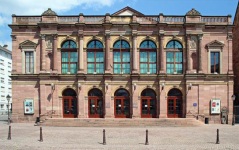
An excellent example of early Gothic architecture, the Dominican Church was founded in 1283 and construction began in the 14th century. With its simple and serene architecture, the church offers an insight into the lives of the Dominican preachers. This mendicant order contributed to the interest in mystical philosophy during the 14th and 15th centuries. Splendid stained-glass windows allow light to flow into the sanctuary and offer inspiration to worshipers. The choir displays the famous "Virgin of the Rose Garden," a masterpiece painted by Martin Schongauer in 1473. Part of the church occupies the former Dominican monastery, with a 14th century cloister once used for serenade concerts. The cloister now houses the Municipal Library of antique manuscripts. From the Dominican Church, it is a short walk to the Rue des Clefs, the main shopping street of Colmar's Old Town.
Address: Place des Dominicains, Colmar.
5.Koïfhus, Ancienne Douane (Old Custom House)
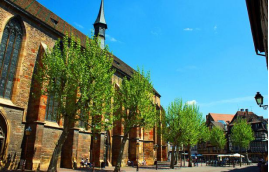
Near the Place du Marché-aux-Fruits (the site of the old fruit market) and at the intersection of the Grand Rue and the Rue des Marchands, the Koïfhus had a strategic location in medieval times. This 15th-century building was once the economic and political center of Colmar. The ground floor was used as a warehouse for goods and a place to collect taxes on imports and exports. The first floor was the council chamber for the Décapole, the federation of imperial cities. You can still see the coats of arms of the ten cities on the windows. The east side of the Koïfhus faces the Place de l'Ancienne Douane with a Bartholdi fountain commemorating the Imperial General Lazarus von Schwendi. The building also has two adjoining wings created in the 16th century and a distinctive tile roof, the result of a 19th-century renovation. From the Koïfhus, visitors can easily reach the Grand Rue, one of the town's main thoroughfares that is lined with shops and restaurants.
Address: Place de l'Ancienne Douane.
Source: https://www.planetware.com/tourist-attractions-/colmar-f-a-col.htm
6.Quartier de la Krutenau (Little Venice)

Just past the Rue Saint Jean, the Krutenau Quarter is a picture-perfect neighborhood with canal-side restaurants, quaint pedestrian bridges, and colorful half-timbered houses. Lush greenery and willow trees line the river, while flourishing potted flowers decorate the houses adding to the pleasant ambience. This quarter is known as "Little Venice" because the houses are built right on the edge of the Lauch River canal, and small boats take passengers on scenic rides. To get a feel of Little Venice, visitors may begin a walking tour at the Rue de la Poissonnerie and continue along the canal until the Rue Turenne that traverses the quarter. From the bridges on the canal, sightseers can enjoy lovely views of the quarter's charming houses and the tower of Saint Martin's church in the distance.
Sources : https://www.pau.fr/article/le-musee-des-beauxarts-devoile-une-collection-connue-du-monde-entier
VI.History
Origin of name: The first mention of Colmar is in a chronicle of the Saxon wars of Charlemagne, emperor of the West (800–814).
The rise of the city: In 1226 Colmar was raised to the status of an imperial town by the Holy Roman emperor Frederick II and was surrounded by defensive walls. Civil rights were granted to it by Rudolf of Habsburg in 1278. In 1632, during the Thirty Years’ War, it was occupied by Sweden. Louis XIII of France took the town under his protection in 1635; it was later gradually annexed by France during 1648–78. Colmar was twice annexed by Germany: from 1871 to 1919 and again during World War II. 2 February 1945 is a key date in the city’s history, the most important of the 20th century. For thepeople of Colmar, it marks the end of the Second World War with the battle of the “Colmar Pocket”, the last onFrench soil and which incurred extremely heavy losses.
Sources: https://www.investinpaupyrenees.com/vivre/histoire/?lang=en
VII.Other information
Many parks and public gardens are scattered across the city. In total, these are 108ha of greenery and 33ha of family gardens. This has resulted in the city being rewarded with the "Ville Fleurie" label with 4 flowers since 1984 in the list of cities and villages in bloom.
For the periods 2010 - 2012 and 2012 - 2014, the City of Colmar was awarded the "ribbons of sustainable development". This label is awarded to local authorities which effectively integrate sustainable development into all of their policies.
Sources : https://www.colmar.fr/ville-laureate
VIII.Contact information
Address of Colmar town hall:
Mairie de Colmar
1 place de la Mairie
BP 50528
68021 Colmar Cedex
Phone number: 03 89 20 68 68
Fax: 03 89 23 97 19
E-mail: contact@colmar.fr
Website: http://www.colmar.fr
Mayor : Gilbert Meyer (Mandat : 2014-2020)
Sources : http://www.cartesfrance.fr/carte-france-ville/68066_Colmar.html#mairie
